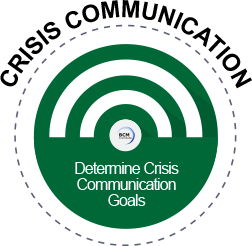Setting Goals for Crisis Communication (CC)
People often fail to communicate effectively due to a lack of clear communications goals and key messages to support them.
The goals of a Crisis Communication Plan should be made clear to the entire organisation.

Key CC Objectives
The key objectives are to:
- Inform audience to be able to make knowledgeable decisions.
- Build trust and credibility.
- Persuade and convince, appropriate to what an organisation knows.
These include:
- Define the Crisis.
- Establish the Crisis Communication organisation.
- Implement the Crisis Communication Plan and procedures.
- Establish Benchmarks to Return to Normalcy.
The real goal of Crisis Communication is to send the right message to the right audience at the right time, utilising the most effective tools available.
Setting goals and identifying support messages are choices that should be made prior to the issuing of any public comment and are especially important in a crisis.
Example of CC Goal |
Goal of CC Plan
The goal is to handle the situation skillfully so that it will never be visible to the public and media. Most crises will never be reported in the media because it was handled satisfactorily with a well develop and implemented Crisis Communication Plan.
CC Goal #1: Ease public concern
- The risk is small.
- The illness is treatable.
- It is not easily contracted.
- Symptoms are easily identified
CC Goal #2: Give guidance on how to respond
- Take these precautions.
- If possibly exposed, contact a physician.
- If symptomatic, contact a physician.
- Note possible symptoms in others.
Communication Goals
Examples of communication goals are:
- Compassion and understanding.
- Accurately reflect camp actions.
- Position camp as a good citizen, credible source of information.
- Report and interpret the crisis putting damaging information in perspective.
- Maintain contact with audiences.
- Achieve a quick resolution.
- Gain knowledge.
Define the Crisis
There is a need to define crisis in terms that are understandable and applicable to the organisation. Different organisations encounter different types of crises depending on their location, ownership structure, position, focus in their industry, level of preparation, and the threats faced.
Based on practical experience, it is imperative that defining the real terms in the family of crises that could endanger the existence of an organisation helps to elevate the practicality and importance of the Crisis Communication Plan development effort.
Establish the Crisis Communication Organisation
Build an organisation to deal with the crisis immediately before and during the crisis, as well as during the recovery stage. These individuals need to be of a particular breed that can make strategic decisions in the midst of chaotic circumstances and inadequate information.
Implement Crisis Communication Plan and Procedures
Establish procedures for fast access to internal and external resources when needed. In times of crisis, normal procurement channels will not be acceptable. It is necessary for those who are involved in crisis management to access the recovery tools immediately. In addition, the standard chain of command may be unworkable. Key individuals may be unavailable, and communication paths may be slow and unreliable. If a natural disaster causes a crisis, there may be dwindling of available supplies due to increasing demand by all organisations in a particular region.
Establish Benchmarks to Return to Normalcy
Establish benchmarks to signal when the organisation is ready to move out of Crisis Communication operations and back to some level of normalcy. The Crisis Communication operations mode is not an efficient business model. Established metrics can help signal the Crisis Communication Team to begin the transition back to normal operations.
 Reference
Reference
Goh, M. H. (2015). A Manager's Guide to Implementing Your IT Crisis Communication Plan. Business Continuity Management Specialist Series. Singapore: GMH Pte Ltd.
Extracted from "Chapter 5 Determine Crisis
Communication Goals"
More Information About Crisis Communication Blended Learning
To know more about our blended learning program and when the next course is scheduled, feel free to contact our friendly course consultant colleagues via sales.ap@bcm-institute.org. They are the BL-CC-3 Blended Learning CC-300 Crisis Communication Implementer and the BL-CC-5 Blended Learning CC-5000 Crisis Communication Expert Implementer.
 |
||
 |
 |
Please feel free to send us a note if you have any of these questions to sales.ap@bcm-institute.org |




![FAQ [BL-CC-5]](https://no-cache.hubspot.com/cta/default/3893111/20839722-3dbc-4dcb-a2bf-9e451632f722.png)

